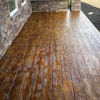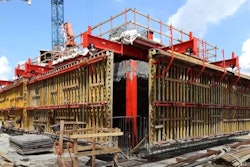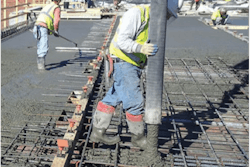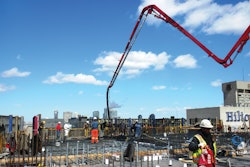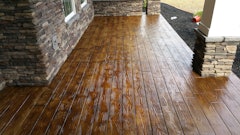
By Jason Wimberly
As architects design new high-rise buildings taller and with more complexity, producers are challenged to deliver ready-mix concrete that can be pumped, placed and finished effectively for these structures.
High-rise buildings (defined as those that are 75 ft. or higher from the lowest level of fire department vehicle access to the floor of highest occupiable space) typically require higher strength concrete. For taller, more design-forward, concrete-framed structures, the design concrete compressive strength may be 10,000 psi or more. There may also be requirements for Modulus of Elasticity. Producing this high-strength, high-performance mix, however, sometimes requires sacrificing some of the typical workability-related characteristics of the concrete.
Pumpability also becomes increasingly difficult the higher the structure. High-range water reducers help disperse the cement better in these applications, while rheology modifying admixtures can help improve other functional characteristics of the mixture. Choosing the right water reducer and rheology modifier can be complex, as there are multiple factors to consider.
Balancing Multiple Goals
When it comes to supporting high-rise construction, concrete producers want to create mixes that are strong and workable, yet don’t break the budget. Identifying the right mix to meet these goals requires delving into all elements of the concrete proportioning and production process, including materials management and project specifications. Common considerations include:
● What type of aggregates do you have access to and what type of aggregates are you willing to use?
● Do you have a history of producing high-strength concrete?
● What are your current mix proportions and performance and associated costs?
● What limitations do you have (ex: a limited number of silos for storing cementitious materials)?
● What are your goals? (ex: If you’re concerned about reducing the variability from batch to batch, you may want to optimize the mix to have a low degree of production variance. However, it’s likely the mix constituency costs would then be higher.)
The more we drive a mix with chemicals, the greater the load-to-load variability in production. But the reality is that concrete requires the use of admixtures. The question is how much and what type and to what extent.
Having a concrete admixture partner helps with these making informed decisions that improve ROI and accelerate the project timeline. The GCP Technical Services team helps producers to balance their project goals and optimize their mix designs, providing mix-design consulting advice as well as lab tests to validate findings.
Optimizing Concrete Mix Designs
Optimizing mixes involves the convergence of the Four F’s: fit, function, finish, and finance.
● Fit: Does the proposed mix design fit the spec?
● Function: Does the resulting concrete function well in production? In other words, can you take it from the lab to the plant and make it work?
● Finish: Does the concrete have a good finish to it? Does it perform how we need it to in the field? For example, if it’s a horizontal application, is it finishable? For a vertical application, does it provide a suitable surface finish?
● Finance: What is the cost? The overall cost is impacted not just by the cost of materials and the proportioning. If you can’t consistently produce the mix from load to load, for example, that results in rejected loads and, ultimately, higher costs.
Producing Consistent Concrete
One of the most difficult aspects of concrete production is producing concrete consistently from load to load. Achieving consistency across loads is particularly vexing with high-strength concrete, as minor changes in material properties from load to load, such as aggregate moistures, can have a significantly more measurable impact. Additionally, mixer driver habits such as those washing-down a truck must be addressed and often corrected.
The VERIFI in-transit concrete management system from GCP Applied Technologies helps producers both achieve greater consistency across loads, and helps optimize mixes. The VERIFI system’s batch screen very quickly alerts producers to potential changes in materials going into the concrete on a load-to-load basis. It can then automatically increase the slump while the concrete is en route to the jobsite, adding water and/or admixtures as needed and instructed to deliver the concrete within spec.
The taller the skyscraper, the stiffer the concrete may need to be, and consequently the higher the modulus of elasticity will be specified. Even slight differences in the amount of air and water in the mix can alter it considerably, so for high-rise applications, having a system like VERIFI becomes even more crucial for reproducing the right mix.
Author Bio
Jason Wimberly manages engineering services for GCP Applied Technologies (GCP) for the Eastern U.S. and Canada. His responsibilities include providing technical consultation and training to GCP’s account and technical services teams, customers and the design community, assisting in new product development, and participation in industry technical committees. His primary activities are centered around the engineering support of GCP’s STRUX line of synthetic macro fibers and technical support of high performance concrete across the Southeast US.
